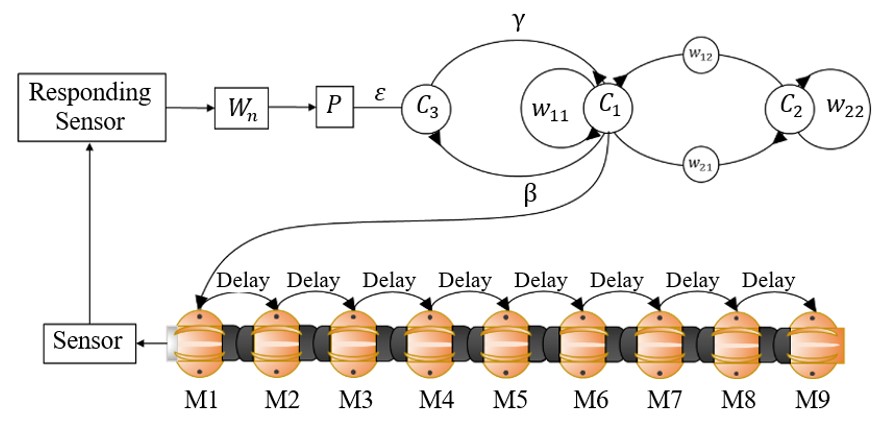Investigating Adaptive CPG-based Control of a Snake Robot with Switch Signal Input for Maneuvering in Varying Environments
Main Article Content
Abstract
This study makes an essential contribution to robotics by revealing how to manage snake robots using adaptive Central Pattern Generators (CPGs) with switch signal input. The work optimizes CPG hyperparameters, characterizing robot behavior to improve navigation in obstacles and limited areas. Three indices are used to evaluate parameter adjustments: index based on moving time, index based on movement frequency, and index based on movement path. Quantitative investigation reveals how these hyperparameters influence the efficiency and adaptability of snake robots across situations. The findings emphasize the effectiveness of the proposed methodology by emphasizing quantitative values resulting from parameter modifications. The work uses stringent testing criteria to identify ideal parameter values (𝜇 = 0.8, A = 0.007, B = 0.005), boosting the approach's resilience and applicability.
Article Details

This work is licensed under a Creative Commons Attribution-NonCommercial-ShareAlike 4.0 International License.
This work is licensed under a Creative Commons Attribution-NonCommercial-ShareAlike 4.0 International License.
References
Manzoor S, Choi Y. A unified neural oscillator model for various rhythmic locomotions of snake-like robot. Neurocomputing. 2016;173:1112-1123.
Blanchard D, Aihara K, Levi T. Snake robot controlled by biomimetic CPGs. J Robot Netw Artif Life. 2019;5(4):253-256.
Hu WJ, Zhao LY, Yan JL, Li JX, Wang ZL. Locomotion patterns based on a CPG model of snake robot. Proceedings of the 3rd Annual International Conference on Mechanics and Mechanical Engineering (MME 2016); 2016 Dec 16-18; Chengdu, China. Amsterdam: Atlantis Press; 2017. p. 588-593.
Haghshenas-Jaryani M. Dynamics and computed-muscle-force control of a planar muscle-driven snake robot. Actuators. 2022;11(7):194.
Baysal YA, Altas IH. A fast non-dominated sorting multi-objective symbiotic organism search algorithm for energy efficient locomotion of snake robot. Comput Sci Inf Syst. 2022;19(1):353-378.
Szadkowski R, Prágr M, Faigl J. Self-learning event mistiming detector based on central pattern generator. Front Neurorobot. 2021;15:629652.
Tang C, Shu X, Meng D, Zhou G. Arboreal concertina locomotion of snake robots on cylinders. Int J Adv Robot Syst. 2017;14(6):1-13.
Wang G, Chen X, Han SK. Central pattern generator and feedforward neural network-based self-adaptive gait control for a crab-like robot locomoting on complex terrain under two reflex mechanisms. Int J Adv Robot Syst. 2017;14(4):1-13.
Wang M, Yu J, Tan M. CPG-based sensory feedback control for bio-inspired multimodal swimming. Int J Adv Robot Syst. 2014;11(10):1-11.
Nachstedt T, Wörgötter F, Manoonpong P, Ariizumi R, Ambe Y, Matsuno F. Adaptive neural oscillators with synaptic plasticity for locomotion control of a snake-like robot with screw-drive mechanism. 2013 IEEE International Conference on Robotics and Automation (IEEE ICRA); 2013 May 6-10; Karlsruhe, Germany. USA: IEEE; 2013. p. 3389-3395.
Transeth AA, Pettersen KY, Liljebäck P. A survey on snake robot modeling and locomotion. Robotica. 2009;27:999-1015.
Tamura H, Kamegawa T. Parameter search of a CPG network using a genetic algorithm for a snake robot with tactile sensors moving on a soft floor. Front Robot AI. 2023;10:1138019.



